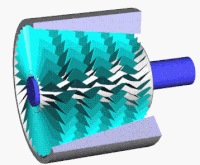
Photo from wikipedia
One challenge that plagues the high-speed operation of rotorcraft is the inherent increase in size of the reverse flow region on the retreating side of the rotor disk. The present… Click to show full abstract
One challenge that plagues the high-speed operation of rotorcraft is the inherent increase in size of the reverse flow region on the retreating side of the rotor disk. The present work experimentally investigated a portion of the reverse flow region on a 1.7- m-diameter sub-scale slowed rotor at advance ratios up to $$\mu =0.9$$μ=0.9 and three shaft tilt angles $${\alpha _{\text {s}}=-\ 4^\circ ,\,0^\circ ,\,4^\circ }$$αs=-4∘,0∘,4∘. Two-component time-resolved particle image velocimetry was used to characterize the flow field around a blade element in the reverse flow region, nominally positioned at $$\psi =270^\circ $$ψ=270∘ and $${y/R=0.4}$$y/R=0.4. Four dominant flow structures were observed: the reverse flow entrance vortex, the blunt trailing edge wake sheet, the reverse flow dynamic stall vortex, and the tip vortex. Analyses are focused on the reverse flow dynamic stall vortex due to its influence on unsteady airloads, and similarities to that of a leading edge vortex over a rotating or surging wing at high angle of attack. The number of semi-chords traveled by the blade element through the reverse flow region directly affects the strength, trajectory, and estimated vortex-induced pitching moment of the reverse flow dynamic stall vortex. Shaft tilt angle also has a strong effect on the evolution of the vortex, with forward shaft tilt resulting in dramatically increased strength and size. The results of this characterization and sensitivity study serve as a reference for evaluation of numerical simulations and aid in the development of low-order aerodynamic models of the reverse flow region and resulting force histories. Collectively, these tools will be used to better predict airloads, wake interactions, and vibrations of rotors operating at high advance ratios.
Journal Title: Experiments in Fluids
Year Published: 2018
Link to full text (if available)
Share on Social Media: Sign Up to like & get
recommendations!